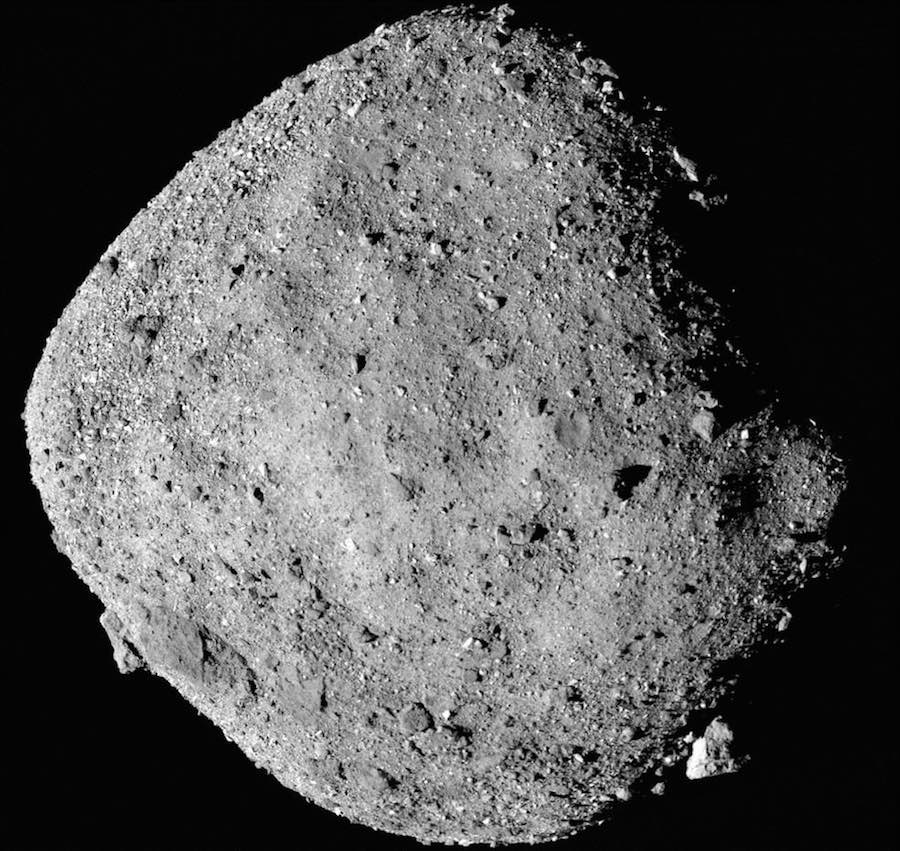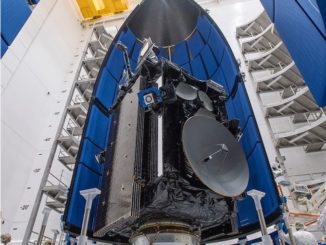
Some time next year, NASA’s OSIRIS-REx spacecraft will descend to the boulder-strewn surface of asteroid Bennu, reach out with a robotic arm, and fetch a sample for return to Earth, but an initial survey of the space rock millions of miles from Earth suggests the robotic mission may have few suitable targets for the touch-and-go maneuver.
OSIRIS-REx is still in the early weeks of its stay at asteroid Bennu, a roughly 1,640-foot-wide (500-meter) object that oscillates inside and outside of Earth’s orbit on each trip around the sun. Bennu’s proximity to Earth, which makes it an impact risk to the planet in the distant future, allowed ground-based radars to scan the asteroid in detail, revealing its size and shape before OSIRIS-REx’s launch in 2016.
The radar observations made by stations at Arecibo, Puerto Rico, and Goldstone, California, did a “phenomenal job of predicting the shape and topography of the asteroid for us,” said Dante Lauretta, principal investigator for the $1 billion Origins, Spectral Interpretation, Resource Identification, Security, Regolith Explorer mission at the University of Arizona, Tucson.
On its approach to the asteroid last year, OSIRIS-REx showed Bennu is shaped like diamond, or a spinning top, just as the radar observations suggested.
“It’s really good news that we got it so right, and that all our mission design plans are valid as we move forward,” Lauretta said Wednesday at a meeting of NASA’s Small Bodies Assessment Group, a community of scientists with research interests in asteroids, comets and other small objects in the solar system.
“We do have the expected, so-called ‘spinning top’ shape, which seems to be characteristic of a subset of the near-Earth asteroid population,” Lauretta said.
“One of the reasons we think it’s top-shaped is because it’s been accelerated by thermal pressures to sort of spin up,” said Olivier Barnouin, a co-investigator on the OSIRIS-REx mission from the Johns Hopkins University Applied Physics Laboratory. “You can imagine if you take a top and start spinning up, if you have little rocks on it, things might go flying off.”
OSIRIS-REx’s cameras searched for evidence of moons or debris around Bennu late last year.
“We can confirm, to this point, that we have not identified any rocks that are flying around, and that there’s no risk to the spacecraft, which actually I think is kind of remarkable because this place is very dynamic,” Barnouin said in a Dec. 31 presentation of the mission’s preliminary findings at Bennu.
But Bennu did present some surprises to scientists, such as its jagged, craggy terrain covered with a collection of boulders, rock piles, craters and ridges.
“Some of the things that jump out at us right away from the asteroid’s surface are the large boulders,” Lauretta said Wednesday. “We are a looking at a pretty rough and rugged surface, more so than we expected.”
The first detailed images from OSIRIS-REx suggest Bennu exhibits the scars from collisions with other objects in the solar system, perhaps when Bennu orbited in the main asteroid belt between the orbits of Mars and Jupiter. The basins include up to a dozen large impact craters that measure up to 500 feet (150 meters) in diameter, according to Lauretta.
“We’re thinking that the asteroid surface’s cratering age may be older than we expected, and may record its collisional history in the main asteroid belt,” he said.
Scientists believe the asteroid’s visible surface may be between 100 million and 1 billion years old, and Lauretta says Bennu is likely a “rubble pile” asteroid, made by the merging of several distinct objects. With the data already returned by OSIRIS-REx, scientists have calculated Bennu has a bulk density just 20 percent higher than that of water, and a bit less than that of Jupiter.
Officials marked OSIRIS-REx’s arrival at Bennu on Dec. 3, when the spacecraft flew over the asteroid’s north pole. Subsequent passes over both poles and the equator allowed scientists to calculate the asteroid’s mass, a crucial parameter for planning the probe’s future trajectories.

OSIRIS-REx is currently in the mission’s “Orbital A” phase, following a maneuver Dec. 31 that directed the spacecraft into a slow-speed loop around Bennu that ranges between 1 mile and 1.3 miles (1.6 to 2.1 kilometers) from the asteroid. Due to Bennu’s weak gravity field, thousands of times weaker than that of Earth, OSIRIS-REx travels at a speed of just one-tenth of a mile per hour, or 5 centimeters per second, relative to the asteroid.
The orbital velocity of satellites circling the Earth can be as high as 17,500 mph (7.8 kilometers per second).
OSIRIS-REx has set records, becoming the first mission to orbit an object as small as Bennu, and as the closest any spacecraft has orbited to any planetary body.
The craft’s navigation team on Earth is plotting the location of landmarks and other prominent features on the asteroid’s surface. Beginning next month, OSIRIS-REx will fly on station-to-station trajectories around the asteroid, pulsing its thrusters to cover Bennu globally and periodically move to closer and farther distances.
“The orbit phase is not really a science campaign phase,” Lauretta said. “It’s primarily there for the navigation team to transition from using star fields to landmarks on the asteroid surface. That transition is going very well, and are achieving navigation accuracies that are required for us to depart orbit in about four weeks and begin the detailed survey campaign of the mission.”
When the solar system formed more than 4.5 billion years ago, chunks of rock and ice collided as they circled the sun like the balls on a billiard table, eventually building up planets. The leftovers became asteroids and comets, and scientists believe Bennu still harbors the basic carbon-bearing organic molecules that were present in the early solar solar system, the stuff that may have helped seed life.
The spacecraft carries three cameras — one for long-range viewing, a color camera for mapping, and another imager to take pictures as OSIRIS-REx collects samples from the asteroid’s surface. The rest of OSIRIS-REx’s suite of science instruments includes a thermal emission spectrometer to detect heat coming from the asteroid, a visible infrared spectrometer to locate minerals and organic materials, a laser altimeter provided by the Canadian Space Agency to create topographic maps, and a student-built X-ray spectrometer to identify individual chemical elements present on the asteroid.
Data gathered by thermal emission and visible infrared spectrometer instruments — OTES and OVIRS — indicates clay minerals on the asteroid’s surface contain hydroxyl molecules with oxygen and hydrogen molecules bonded together. This finding suggests Bennu’s surface was once in contact with water, likely when the asteroid was part of a much larger parent body that was smashed to bits in a collision in the chaotic early solar system.
One prominent feature of Bennu’s landscape is a large boulder protruding from the surface near the south pole. While ground-based radar images suggested the boulder to be at least 33 feet, or 10 meters, in height, OSIRIS-REx imagery indicates is closer to 164 feet, or 50 meters, tall with a width of approximately 180 feet, or 55 meters, according to NASA.
On approach to Bennu, ground controllers at Lockheed Martin in Denver — where OSIRIS-REx was built — unlatched the probe’s robotic arm from its launch restraint for the first time. Over several days, the ground team commanded the arm to bend its joints and jettison a launch cover over the sample collection mechanism, which will release compressed air during a touch-and-go maneuver to force gravel and surface material into an on-board chamber for the journey back to Earth.

One of the darkest features spotted so far on Bennu appears to be rich in magnetite and iron oxide, Lauretta said, based on early spectral measurements from OSIRIS-REx’s instruments. Scientists are intrigued by the darker regions of the asteroid because they are expected to contain more carbon, the scientific pay dirt for the sample return mission.
But officials will evaluate where OSIRIS-REx can safely reach the surface in the coming months, with the tough-and-go descent currently scheduled for July 4, 2020. That can be pushed back a few months, if necessary, before the spacecraft must depart Bennu in March 2021 to reach Earth in September 2023.
“The OSIRIS-REx mission’s sample site selection campaign starts next month, which is when we will start receiving science data at the resolution needed to make informed assessments about the safety of various regions on Bennu,” Lauretta said in a written response Thursday to questions from Spaceflight Now.
“We’re thinking about sampling the surface … and the craters are starting to look as possibly good candidates because they’re fairly smooth in structure, as far as we can tell at this point in the mission,” Barnouin said.
Email the author.
Follow Stephen Clark on Twitter: @StephenClark1.



